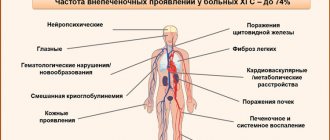Carpal tunnel syndrome or carpal tunnel syndrome is a disease that is very common in the 21st century. It causes dysfunction of the hand and wrist. Appears due to compression of the nerve that passes to the palm and fingers through the carpal tunnel. My fingers don’t “listen” well, I can’t hold objects normally and I have pain at night. In most cases, it occurs due to frequent computer use.
But this syndrome has been known for a long time. Previously, it affected people who, on duty, very often flexed and straightened their wrists. Sometimes such disorders can appear during pregnancy.
This disease is considered one of the most costly occupational diseases.
Causes of the disease
The causes of this disease include the following factors: - professional activity of a person associated with constant monotonous hand movements; - various injuries, fractures, dislocations of the hand, which result in compression of the median nerve; - stagnation of fluid in the body due to pregnancy or taking hormonal contraceptives; - genetic predisposition; - thyroid disease; - diabetes; - inflammatory and rheumatic diseases of the hand; - abnormal bone growth (acromegaly).
Causes
Narrowing of the median nerve occurs due to swelling of the hand muscles and tendons, as well as poor circulation of the muscle tissue. The main causes of this disease are:
- Chronic inflammation in this area.
- Swelling of tissues during pregnancy.
- Frequent hypothermia.
- Benign or malignant tumor of the median nerve.
- Swelling caused by systematic injuries and injuries to the hand.
- Complications of rheumatoid arthritis.
Predisposition to this problem
- People who have diseases of the endocrine system.
- Heredity.
- In the presence of renal failure and tuberculosis.
- Excess weight.
- Women who are taking hormonal medications or during menopause.
- Wrist fracture, especially if it has not healed properly.
- Anomalies in the structure of the carpal tunnel.
- In connection with the workplace.
Symptoms of the disease
The first symptoms of the onset of the disease are pain, tingling, burning and numbness of the fingers. At first they appear from time to time and quickly disappear, but after a while the patient begins to feel them constantly. With the further development of tunnel syndrome, pain occurs at night in the fingers, which can radiate to the forearm and elbow joints. After rubbing or shaking the brush, the discomfort disappears. In addition, the sensitivity of the fingers may decrease, the muscles become weaker, and it becomes difficult for the person to hold small objects.
Symptoms
Carpal tunnel syndrome symptoms and manifestations vary. First of all, there is a feeling of constant tingling. Over time, a burning sensation appears in the thumb, index and middle fingers. Sometimes patients begin to complain of pain in this area. Many patients complain of numbness in their hands and complete loss of sensation. The discomfort disappears if you lower your hand down. But this symptom is a sign of concern. In this case, it is advisable to consult a doctor to diagnose the problem.
If you do not undergo treatment in a timely manner, the symptoms will soon return again. The more the situation worsens, the more the mobility of the joint and fingers is impaired. Soon the patient notices that the person cannot hold an object in his hands. In some cases, there is a change in the color of the skin and poor circulation in the hands.
Carpal tunnel syndrome symptoms have become very common in recent years precisely because of the widespread use of computers, as well as the appearance of flat keyboards. This gradually led to an increase in the incidence of microtraumas of the shoulders, forearms, and hands. Using a mouse further aggravates the situation.
At the moment, all doctors say that prolonged use of a computer increases the risk of carpal syndrome. In most cases, this does not depend on what a person has been doing for a long time: playing on the computer or working. It is important to take short breaks to allow your hands to rest.
Diagnosis of carpal tunnel syndrome
It is difficult for a non-specialist to diagnose neurological diseases whose symptoms are similar. And only an experienced doctor, based on a survey and examination, will be able to make the correct diagnosis.
Diagnosis of carpal tunnel syndrome mainly involves three tests:
1. Tinel test. When lightly tapping the inside of the wrist, the patient feels a tingling sensation in the fingers.
2. Phalen test. If, when flexing and extending the hand for less than one minute, the patient begins to feel pain and numbness in the palm and fingers, then the diagnosis of carpal tunnel syndrome is confirmed.
3. Cuff test. A cuff of a device for measuring blood pressure is placed on the patient's arm. When the pressure is increased slightly above normal and held for about a minute, a person with this disease feels numbness and tingling in the fingers.
Other research methods may be required, such as:
1. Electrodiagnostic, during which the electrical conduction velocity of the median nerve is measured and recorded. 2. MRI is a method that allows you to obtain a detailed picture of the state of human organs without internal intervention using magnetic waves. In this case, photographs of the cervical spine are taken. 3. X-ray – research using radiation. This method is used to take pictures of bones. 4. Ultrasound is a method that uses sound waves to measure the width of the median nerve. This may be needed, for example, to guide injections for pathologies such as carpal tunnel syndrome.
Carpal tunnel - what is it?
Carpal tunnel syndrome, or carpal tunnel syndrome, is a pathology of the peripheral nervous system. It is based on compression of the median nerve in the area of a specific anatomical canal in the wrist (a kind of tunnel), which is where the name of the disease comes from.
The carpal tunnel is located at the junction of the forearm and hand on the palmar side. Its walls are formed by the bones of the forearm (radius and ulna) on one side, 8 small bones of the wrist on the other, between which the transverse carpal ligament is thrown. Inside this peculiar tunnel are the median nerve and tendons of the hand muscles. The size and shape of the canal, the thickness of the transverse carpal ligament are initially different for each person. Those people who have a narrow canal and a thick ligament have an increased risk of developing carpal tunnel syndrome. There is an interesting pattern: carpal tunnel syndrome practically does not occur in representatives of the Negroid race. This disease predominantly affects Europeans. It is quite possible that dark-skinned representatives of humanity initially have a rather wide canal, so their median nerve is not pinched in this area.
That part of the median nerve that passes directly through the canal provides sensory innervation to the palmar surface of the first three fingers of the hand and half of the ring finger (the side facing the thumb), as well as motor innervation of the muscles that provide movement of the thumb (abduction and opposition to the palm and other fingers of the hand). Compression of the median nerve in the canal region leads to changes in sensitivity in these areas and a decrease in muscle strength, which forms the basis of the clinical manifestations of carpal tunnel syndrome.
Treatment
First of all, it is necessary to treat the neurological diseases that underlie the formation of carpal tunnel syndrome. For example, for hypothyroidism, replacement therapy is carried out, and the restoration of impaired functions occurs quite quickly. For women using birth control pills, another method of contraception is offered. If carpal tunnel syndrome occurs as a result of professional stress, treatment involves changing the type of activity.
Physiotherapeutic methods have a good effect: electrophoresis with nicotinic acid, phonophoresis with hydrocortisone, laser therapy, mud therapy.
For successful treatment, it is recommended to limit stress and give the affected arm rest for at least a couple of weeks. In some cases, a splint is placed on the wrist to prevent it from bending. As painkillers and anti-inflammatory drugs, drugs such as aspirin, ibuprofen, diclofenac, nimulide, etc. are used. To reduce swelling of the hands, cold compresses are applied, and diuretics are also used.
Good results are obtained by manual manipulation of the hand, which is carried out to restore the correct position of the wrist bones, as well as by introducing into the carpal tunnel a mixture of an anesthetic (lidocaine, novocaine, etc.) with a corticosteroid hormone (diprospan, hydrocortisone). Usually after the first injection the patient feels significant relief. For recovery, as a rule, three injections of the drug are enough.
In situations where carpal tunnel syndrome is chronic and persistent, surgeons recommend surgical treatment.
Exercises for carpal tunnel syndrome of the hand: gymnastics, video
Exercises for carpal tunnel syndrome of the hand
A set of exercises for carpal tunnel syndrome of the hand is suitable for automatic execution throughout the day, each exercise is repeated 10 times . Here are the exercises of this gymnastics:
- Warm up. Vigorously clench and relax your fists, make circular rotations with each finger separately and with the whole hand together.
- Exercise "Butterfly" . The palms are pressed tightly against each other, while the fingers are moved to the side. Delay in this position for 5 seconds , after which the fingers must be crossed and squeezed tightly for another 5 seconds .
- Exercise "Strings" . The palms and fingers are pressed tightly together. The paired fingers of each hand are moved to the sides in turn and returned to their original position.
- Exercise "Ravine" . The hands are in the “lock”, and the fingers are straightened as much as possible. The fingers are closed and curved downwards, while the wrist is extended as high as possible.
- Exercise "Pinch" . The thumb connects with the rest in turn, touching with pads. The exercise begins with the index finger and back.
- Exercise "Gorka" . Hands at chest level, palms clenched, as if in prayer. The fingers are in constant tension and stretch upward. Without changing the position of the palms, the arms are lowered to waist level and returned back.
- Exercise "Swing" . Palms and fingers are pressed, hands in a “prayer” position - at chest level. It is necessary to alternately press one palm onto the other and return to the starting position.
For more information on how to do these exercises, watch the video.
Surgery
The operation is performed under local anesthesia in a day hospital. There are two types of surgical treatment: endoscopic procedure or open surgery. Depending on the patient’s condition, the doctor decides what kind of intervention is necessary. In open surgery, the skin is cut from the wrist to the palm and the broad carpal ligament is excised, which limits the space in which the median nerve lies. After all the necessary manipulations, stitches are placed on the wound.
Endoscopic surgery is no less effective; in addition, with such an intervention the scar is not particularly noticeable. Using an endoscope, which is inserted into the skin incision, the surgeon excises the ligament.
Carpal (carpal) tunnel syndrome: in what cases is surgery prescribed?
Surgery for carpal (carpal) tunnel syndrome
Surgical intervention occurs if drug therapy, exercise therapy and massages are not effective six months after its start. If the disease progresses rapidly, then surgery must be done immediately. This is especially true in cases where the pain becomes severe, the functions of the hand are limited, or a tumor or cyst appears. There are two types of operation:
Traditional intervention
- It is performed using open access - a surgical method.
- An incision is made in the area of the carpal tunnel, and the transverse carpal ligament is dissected.
- As a result, the median nerve ending becomes free and is no longer compressed by the ligament.
Endoscopic method
- During the operation, a special medical device is used.
- A puncture is made at the top of the carpal tunnel, an endoscope is inserted into the hole, and the ligament in the wrist is dissected.
- Decompression of the nerve ending occurs.
Surgery can be performed on an outpatient basis using local anesthesia. At the end of the operation, tissue swelling is observed and hand movements are limited. Therefore, the patient is prescribed a rehabilitation period. During this time, physiotherapeutic procedures and special gymnastics are carried out. The final restoration of motor functions of the hand occurs within one year.
Postoperative period
To avoid swelling, the operated arm must be kept elevated. Special exercises will help improve finger mobility. After the anesthesia wears off, the sensitivity of the hand will gradually recover.
Self-absorbing sutures placed on the wound disappear within 10 days. If the stitches were made with non-absorbable threads, they will be removed in the clinic after 10-14 days.
The rehabilitation process lasts approximately two months. Most patients return to their normal lifestyle after surgery. For a person with carpal tunnel syndrome, surgical treatment completely relieves the symptoms of the disease; relapses are very rare.
Prevention
Considering that the main cause of the disease is the incorrect position of the hand when working at the computer, it is necessary to adhere to some rules. To prevent carpal tunnel syndrome, doctors recommend:
- Organize your workplace correctly. The table should be of such a height that when working with the mouse and keyboard, the hand does not sag. It should be in line with the forearm.
- Maintain the correct working posture - a right angle between the shoulder and forearm, lower back and hips.
- Choose a comfortable keyboard and mouse so that they help maintain the correct position of the hand. The joystick mouse is designed specifically for people suffering from carpal tunnel syndrome.
- Take breaks from work every 30-60 minutes.
- Perform special exercises to relax your hands - shaking, circular movements in the wrists, squeezing and unclenching your fingers. Massage and the use of an expander will improve blood flow and prevent tissue swelling.
People whose professional activities are associated with the risk of developing wrist syndrome are advised to strictly comply with sanitary and hygienic requirements for performing work operations. Work breaks, no overtime, industrial exercises are the main preventive measures. If initial symptoms of the disease appear, you should seek medical help.
Folk remedies for the treatment of carpal tunnel syndrome
Home remedies have been used by people for many years to treat a condition called carpal tunnel syndrome. Symptoms will not bother you if you change your position while working and take a break for about 15 minutes. If your muscles rest more, your health will improve. You can do simple exercises, such as squeezing a rubber ball. Applying ice to the wrist area has a good effect. In some cases, various plants are used for treatment, the use of which helps to reduce pain in the fingers. Of course, you should consult your doctor before doing this.
Right hand carpal tunnel syndrome: causes
Tunnel syndrome of the right carpal (carpal) tunnel of the hand
In the modern world, several percent of people are susceptible to this disease. Basically, the disease manifests itself in adulthood. Men are less likely than women to suffer from carpal tunnel syndrome on the right hand. In some patients, symptoms decrease over the course of a year without medical intervention. There is a list of causes of the disease:
- Professional. Persons who do their work with their hands are most susceptible. These include musicians, artists, programmers.
- Age-related changes in body cells. The syndrome occurs in women over fifty years of age.
- Swelling that occurs in the area of the carpal tunnel. This may be a consequence of a forearm injury.
- Hormonal changes in women. Observed during pregnancy. As a result, fluid is retained in the membranes of the muscle tendons of the hand.
- Hereditary gene.
- Diseases of the endocrine system.
- The most common are arthrosis and rheumatoid arthritis.
- All kinds of infections and viruses that affect the tissues of the wrist.
- The presence of tumors and cystic formations.
- Mechanical tissue damage in the form of bruises, dislocations, fractures and sprains.
- Connective tissue diseases.
- Tuberculosis (skin, bones, etc.).
In men, occupational causes of carpal tunnel development predominate. Although such a pathology can develop due to heredity, age-related changes or as a result of all kinds of arthritis.
Sea buckthorn treatment
Sea buckthorn remedy helps people with a disease such as carpal tunnel syndrome to cope with pain in the hands. The treatment is as follows. The berries are mashed and mixed with water. The resulting mixture should be opaque. Then you need to heat it to 37 degrees and steam your hands for half an hour. It’s a good idea to do a light massage beforehand.
After the procedure, your hands need to be thoroughly dried and warmed. You can use wool mittens or gloves. Treatment is carried out for a month, then you need to take a break for two weeks.
Diagnostics
Carpal tunnel syndrome is a disease where the diagnosis can be made immediately when you first contact a doctor for medical help. Carefully collected complaints, a neurological examination and a number of some tests that provoke symptoms help the doctor not to make a mistake. What kind of tests are performed during the examination? They are quite simple and do not require any specific equipment. This:
- test, or Tinnel's sign. Its essence is as follows: effleurage (light tapping) at the level of the fold of skin in the area of the wrist joint causes pain and paresthesia in the area of the first 3 fingers (3.5, to be more precise), the palm spreading to the forearm (that is, in those places , where these sensations bother the patient outside of effleurage);
- Phalen test. To carry out this test, it is necessary to bend the hand at the wrist joint at a right angle and hold it in this position for 1-2 minutes. This position provokes numbness, paresthesia and pain in the fingers and hand;
- tourniquet (cuff) test. The shoulder of the affected arm is compressed with a tonometer cuff until the pulse disappears and held in this position for 1 minute. The result is the typical symptoms of carpal tunnel syndrome;
- postural provocation - raising straight arms above your head and holding in this position for 1 minute. The result is the same as with other tests.
If any doubts about the correctness of the diagnosis still remain, then the patient is prescribed an additional research method - electroneuromyography. This method allows you to confirm dysfunction of the median nerve and clarify the location of its damage, as well as distinguish carpal tunnel syndrome from other diseases of the peripheral nervous system (including spinal osteochondrosis).
All of the above is valid only in relation to carpal tunnel syndrome, that is, to clarify this particular diagnosis. If the syndrome itself is the result of some other disease (diabetes mellitus, arthritis, etc.), then other additional research methods may be needed.
How to reduce swelling
Swelling is another unpleasant symptom of a condition called carpal tunnel syndrome. Treatment consists of using diuretic infusions. Drinking an infusion of parsley roots gives excellent results. One tablespoon of raw material should be poured with boiling water (0.5 l) and left to brew until the morning. The healing infusion is drunk one sip at a time throughout the day.
A remedy made from white birch leaves has a similar effect. A few tablespoons of leaves should be poured with boiling water (one glass) and brewed for about three hours. The infusion should be consumed in four doses of 1/3 cup before meals.
Bearberry has excellent diuretic and anti-inflammatory properties. The medicine is prepared in this way: the leaves of the plant (1 tablespoon) are brewed with one glass of boiling water for several hours. Drink a tablespoon of the product several times a day.
Carpal tunnel syndrome - effective treatment without surgery: ointments, exercise therapy, massage, blockade
Carpal tunnel syndrome - effective treatment without surgery - massage
Compression of the median nerve causes a slow decline in fine motor skills of the fingers. At the early stage of carpal tunnel syndrome, when numbness in the fingers only occasionally bothers you, conservative treatment will provide real help:
- Wearing a bandage . It is necessary to ensure rest of the sore limb. During the day, a special orthosis will help immobilize the hand. Before going to bed, the wrist is fixed with a splint.
- Simple muscle stretching exercises performed regularly slow down the development of the disease.
You can do the following exercises:
- Expander compression
- Rotation of a hand closed into a fist
- Flexion and extension of fingers
Remember: If you feel unwell, you should consult a doctor. Treatment must also be prescribed by a doctor.
Here are other methods of effective treatment without surgery:
- During the day, it is useful to take breaks from work for massages and vigorously knead the back of your hand and wrist. You should shake your hands from time to time to remove congestion.
- To relieve pain, ointments with anti-inflammatory drugs are traditionally used to reduce swelling of adjacent tissues: Diclofenac, Nurofen, Pentalgin.
- Physiotherapy - exercise therapy . There are many methods of influencing the affected nerve: electrophoresis, magnetic therapy, phonophoresis, shock wave treatment . Prescribing treatment sessions will improve the supply of oxygen to tissues and restore nerve conduction.
- Blockade . If the patient cannot perform even simple operations with his hands, the most effective remedy is taken - the introduction of medications into the affected area.
The drug mixture is a combination of corticosteroids and anesthetics . Most often, the composition is prepared from hydrocortisone and novocaine. Already the first injection brings relief. The procedure is repeated two weeks later. The final injection is given again after two weeks. If a full course of blockade does not correct the situation, more radical methods of action are chosen - surgery. Read on.
Nutrition and other treatments
The disease can only be cured in a comprehensive way. Along with drug therapy, adherence to a special diet is indicated. Its therapeutic effect is more aimed at the primary pathology that caused the development of the syndrome.
Fatty and fried foods are prohibited during the period of therapy
So, with excess weight, which often accompanies the disease, it is important to adjust nutrition, which will help control body weight and the condition of the joint apparatus. In this case, it is necessary to exclude refined foods, sweets, and fatty meats from the diet. On the contrary, eating seafood, turkey and chicken, nuts, and avocados is beneficial.
Acupuncture, acupuncture, and yoga will be effective for carpal tunnel syndrome. These are non-traditional treatments that are not recognized in official medicine as methods of treating the disease. However, they often give positive results. For example, with the help of yoga sessions you can restore joint mobility and strengthen the entire body.
Carpal tunnel syndrome is an enemy that must be fought
A century ago, this disease affected clerks who spent many hours continuously copying tons of paper, but in our time no one is immune from this disease.
Not only copywriters who write texts, but also computer scientists, programmers, webmasters, all freelancers whose working tool is a mouse and keyboard.
Even gamers who spend many hours playing games behind their monitor screens are susceptible to this disease.
The main signs of carpal tunnel syndrome:
- tingling;
- numbness;
- trembling in the fingers;
- severe pain in the wrists.
How to prevent computer mouse syndrome?
The first thing you need to do in the fight for the health of your hands is to properly organize your workplace.
Let's decide on the geometry of the working (correct) position of the hands.
- 30o - 40o is the angle recommended between the hand and the table surface.
- 90° is the optimal angle between the forearm and shoulder when working on the keyboard; it is advisable not to place your hands close to your body, but not too far away, otherwise the arm muscles will be overly tense.
- 180° is the angle that must be maintained between the hand and forearm, the hand should be a continuation of the forearm, and should not deviate to the sides or vertically, the fingers and hand should lie on the same axis.
Medications
In the treatment of carpal tunnel syndrome, medications that act symptomatically are used. These help reduce the intensity of pain and the severity of the inflammatory process. Non-steroidal anti-inflammatory drugs are used as the basis for drug therapy. This group includes Movalis, Diclofenac, Nurofen, Ibuprofen, Nimesil.
Diuretics help eliminate local swelling. Only a doctor selects hormonal drugs, because incorrect therapy with them can aggravate the situation and cause additional harm to health. In addition, taking muscle relaxants that relieve muscle tension and vasodilators is indicated.
Also read:
How to treat a pinched nerve in the leg
To increase the protective function of the body and improve the general condition of the joint apparatus, vitamin complexes are prescribed. These help speed up recovery and improve metabolic processes. For carpal tunnel syndrome, B vitamins and ascorbic acid will be useful:
- B6: ensures restoration of nerve endings, reduces pain symptoms and swelling in the affected area;
- B12: improves immunity, restores damaged nerves;
- C: normalizes hematopoietic function, has an anti-inflammatory, strengthening effect.
If oral medications are ineffective, local administration of drugs to the affected area is prescribed. This is necessary to restore wrist function. In this case, corticosteroids and anesthetics will be effective: Lidocaine, Novocaine, Diprospan, Hydrocortisone.
Among hormonal agents, preference is given to Hydrocortisone
Already after the first administration of the drug, a decrease in the severity of symptoms can be observed. The second injection is administered after approximately 14 days, the third after 21 days. It is not recommended to carry out the procedure more often, because hormonal drugs can cause side effects.
It is possible to get rid of the pathology faster if drug therapy is combined with rational physical activity, a healthy lifestyle, and a special diet. When the disease is detected at the initial stage of development, conservative treatment can eliminate unpleasant symptoms within 1-2 weeks.
At-risk groups
In principle, each of us may need treatment for the wrist joint, which will restore the hands to their former mobility, the ability to lift your own child, pet a dog, or easily perform professional duties. But for some people, the risk of becoming semi-disabled (and sometimes completely) for a long time is much higher. These include:
- those who are engaged in heavy physical labor , where the load falls mainly on the hands. For example, rowers, loaders, lumberjacks;
- office workers - from secretaries to programmers. Here the risks even increase, since many of these employees work in non-design conditions. For example, the ratio of the height of the table and the chair is not observed, and excess pressure is constantly placed on the wrists;
- athletes whose hands are actively and constantly working - badminton players, tennis players, boxers (the latter are at greatest risk in terms of injuries and bruises of the wrist joint);
- people whose profession requires constant use of fine motor skills . These include seamstresses and lacemakers; signers of dishes, eggs, cups; musicians, especially those who play stringed instruments and those who work with the piano.
Treatment of the wrist joint may also be required for ordinary people - those who cannot imagine life without playing online games. Spending a lot of time at the computer, such people have to make a huge number of monotonous movements with the hand, which seriously overload the radial joint. At a certain stage, this approach to one’s own hands turns into acute illnesses that turn into chronic forms.
Major diseases
Listing all the pathologies that can affect the wrist joint is a long process. Let us dwell on those that doctors encounter especially often.
Carpal Tunnel Syndrome
The disease is caused by compression of the mentioned canal, the nerves passing through it are under pressure from the swollen tissues. Swelling is caused by inflammation or stress - monotonous and monotonous or short, but excessive.
A typical manifestation of the syndrome is an increase in pain intensity during night rest. Many patients complain of persistent numbness that affects the middle, index and thumb. Weakness and clumsiness of the entire hand or part of it are also common.
Osteoarthritis
It develops due to wear and tear of the cartilage tissue that covers the surface of the joint. In later stages, bone damage also develops. The wrist joint becomes deformed and loses mobility. The process is slow, accompanied by pain that gradually increases in intensity.
Characteristic symptoms:
- decreased hand mobility, especially noticeable in the morning;
- swelling in the joint area;
- pain not only during movement, but also at rest;
- crunching in the joint;
- rise in temperature in the affected area;
- pain on palpation of the joint.
Osteoarthritis develops as a result of injury, prolonged poor hand position, or age-related tissue degradation.
Tenosynovitis
With this disease, the tendons and tendon sheaths become inflamed. The reasons for its development are still the same: tension in the hand, excessive one-time or chronic, from monotonous movements or microtrauma.
Signs of tenosynovitis include: pain when palpating muscles and tendons, thickening at the site of the lesion, local increase in temperature, pain with even slight tension (for example, when clenching your palm into a fist).
Lack of timely diagnosis and proper treatment can lead to unpleasant consequences. Tenosynovitis does not threaten death, but partial loss of working capacity does. In this regard, it is enough to recall Robert Schumann, a composer and music critic who began as a pianist, but lost the opportunity to play music precisely because of chronic tendovaginitis.
Arthritis of reactive and rheumatic nature
They are a consequence of prolonged inflammation in the patient’s body, the presence of chronic pathologies, primarily tonsillitis, myocarditis and pyelonephritis.
The same consequences can be caused by systemic diseases that affect the connective tissue or epidermis - gout, psoriasis, ankylosing spondylitis, or lupus erythematosus. But the pain is not localized exclusively to the wrist joint. It also affects the back, ankles, knees and the spine itself. In the morning hours, a feeling of stiffness covers the whole body, and the pain syndrome, especially intense at this time, gradually subsides, and by the evening disappears completely.
Arthrosis
It occurs as a result of inflammation, injury, stress caused by occupational specifics, and age-related changes. It is difficult to diagnose arthrosis of the wrist joint in the early stages - the pain is mild, and the patient usually does not pay attention to it. As well as the crunch that appears when moving. The patient goes to the doctor when the pain becomes constant. Swelling with arthrosis is practically not observed, and there is no rise in temperature, even local. The pain is especially noticeable with maximum flexion of the hand, lifting something heavy, or leaning on the palm.
Hygroma
This is the name of a cyst on the wrist that looks like a lump. It forms gradually, at first it does not cause painful sensations and does not limit movements, so the patient simply does not notice the hygroma. As it grows, tissues and nerve endings are compressed; At first there is discomfort, later it gives way to pain. Failure to take measures at this stage leads to protrusion of the formation by 2-5 centimeters, a significant limitation in the mobility of the hand.
Most often, hygroma occurs in those who are at risk. However, it can also appear as a result of a hereditary predisposition, as well as physical damage: an unsuccessful fall with emphasis on the wrist, sprain of one of the ligaments, dislocation or fracture. But such a lump can form without any reasons (at least visible) or prerequisites. Moreover, hygroma develops in people of any age, from small children to very old people.
Injuries
They can be diagnosed by the victim himself: the pain is very vivid, sometimes reaching the level of unbearable. What exactly is injured in the wrist joint can only be determined by a doctor, since the head of the bone may shift, the tendon may rupture, or the wrist itself may break. The last injury is considered the most difficult.
With a traumatic injury to the wrist joint, there is acute pain, rapid swelling of the soft tissues, limited mobility of the hand or a complete inability to move it. Sometimes there is deformation of the forearm.
How to determine the likelihood of carpal tunnel syndrome?
With the proliferation of computer technology and mobile phones, a rare occupational disease is becoming a common threat. Long hours of monotonous mouse movements or keyboard work lead to inflammation and swelling of the tissues, causing severe pain and impaired movement in the joints of the fingers and wrist. Subsequently, due to constant compression of the nerve passing between the bones of the wrist from the palm, inflammation occurs. In this case, we are already talking about CTS (carpal tunnel syndrome), a neurological and very serious disease.
Those who spend a lot of time at the computer can use an express method for diagnosing the onset of the disease. Stand up straight. Raise your arms in front of you to shoulder level, slightly bending them at the elbows. Connect the brushes with the back sides. Bend your elbows and lower your hands down without tension. The correct position would be:
- elbows at shoulder level directed to the sides;
- forearms are horizontal and parallel to the chest line;
- the hands are connected at the back and bent at the wrists at an angle of 90º;
- fingers point down and relaxed.
If within 60 seconds a person feels pain, tingling or other unpleasant sensations in the wrists, then he should immediately take action to prevent carpal tunnel syndrome. It consists of maintaining the correct hand position when working with the keyboard and relaxing tense hand muscles. It is advisable to visit a neurologist to make sure of your own health or to notice the onset of the disease in time.
Carpal tunnel syndrome - surgery: reviews of this treatment for carpal syndrome
Carpal Tunnel Syndrome
If you have developed carpal tunnel syndrome and your doctor orders surgery, read reviews from other people about this treatment for carpal tunnel syndrome. They describe their feelings and the results of the surgical intervention.
Olga Ivanovna, 55 years old
I will share my experience in treating carpal syndrome. About three years ago I started having problems with my hands. Either they went numb, they hurt periodically, or there were unpleasant sensations, as if goosebumps were crawling, but for some reason I attributed everything to cervical osteochondrosis. And when my right hand became swollen and very painful, I turned to a neurologist. He said I had carpal tunnel syndrome and referred me for surgery. The surgeon performed it in 20 minutes under local anesthesia. On the third day I was discharged and was told that I needed to take care of my hand for another three months. After the operation, all disturbing symptoms disappeared.
Irina, 32 years old
Due to the fact that I type a lot (I work as a secretary), I gradually developed carpal tunnel syndrome. My hands hurt day and night. I decided to have surgery. They did it quite quickly, then they told me to apply cold to the operation site for a day. By evening you could do light movements and start working out. On the 3rd day I was discharged and advised to go to the clinic on the 10th day and have the stitches removed. I feel good now.
Galina, 45 years old
Working on a computer for a long time resulted in me acquiring carpal tunnel syndrome. My hands began to go numb and hurt so much that I woke up from the pain at night. Tablets and ointments stopped helping. I found a suitable clinic where I had surgery, which was successful. Upon discharge, the doctor told me that sensitivity would take a long time to recover, because the compression of the nerve was prolonged. Therefore, I advise those who suffer from a similar syndrome not to delay the operation.
Physiotherapy
For carpal tunnel syndrome, you can undergo courses of physiotherapy, which help eliminate unpleasant clinical manifestations and reduce the severity of the inflammatory process. For example, the following sessions will help reduce pain symptoms:
- transcranial electroanalgesia;
- electrophoresis using analgesics and anesthetics;
- cryotherapy (cold treatment);
- fluctuarization.
On a note! The severity of swelling and inflammation is reduced when exposed to ultra-high-frequency therapy and electrophoresis with anti-inflammatory drugs.
Courses of the following physical procedures will help improve microcirculation and nutrition in the affected area:
- high-frequency magnetic therapy;
- electrophoresis using vasodilators;
- local darsonvalization;
- vibration therapy;
- ultratonotherapy;
- therapeutic massage.
Ultrasound, laser therapy, ozokerite treatment, and mud therapy will help speed up tissue regeneration. To improve neuromuscular conduction, neuroelectric stimulation is prescribed.
Operation
If conservative therapy does not relieve pressure in the carpal tunnel, surgical treatment may be recommended. During surgery, the transverse carpal ligament is most often cut, which increases the size of the canal and frees the nerve. This treatment is performed on an outpatient basis through a small incision in the palm using local anesthesia.
After surgery, rehabilitation takes several months. Usually, carpal tunnel symptoms disappear immediately when the pressure on the nerve is relieved, but it is necessary to repair the ligament and wait for the incision to heal. At first, the hand is held in a scarf; it is better to keep it higher in the first days. Ice and NSAID tablets can be used to prevent pain and swelling. After the stitches are removed, physiotherapeutic procedures are used for rehabilitation.
To speed up healing, ice wraps, magnetic therapy, and ultrasound are used. Massage and special exercises are useful. Finger movements should be carried out from the first day after surgery. And it’s better to start more serious classes with modeling from special soft plasticine. Then you can perform movements with your fingers and hand, gradually increasing their intensity.
Carpal tunnel syndrome is not life-threatening for the patient. But it seriously impairs performance and causes discomfort. Therefore, it is advisable to immediately begin to eliminate compression of the nerve so that complications do not develop.
Medical diagnosis
A neurologist will make a diagnosis only after a detailed history, examination and tests.
There are many physical therapy exercises that help identify the presence of carpal tunnel syndrome:
- Tinel's syndrome is a tapping sensation over the area where the nerve passes. The patient's fingers usually begin to tingle immediately.
- According to the Phalen test, the patient is asked to make several active strokes of the brush with a wide amplitude, which cause increased pain, tingling and numbness.
Electromyography, which studies muscle contractions, can also detect carpal tunnel syndrome. This examination will help determine the extent of the lesion and locality in order to begin effective treatment.
What symptoms are you worried about?
Inflammation of the wrist joint causes swelling.
Patients with carpal tunnel syndrome primarily complain of loss of sensation in the thumb, index, middle, or ring fingers. I am also concerned about pain and tingling that does not go away even in a calm state. Swelling occurs near the wrist joint, which spreads to the palms, making it impossible to fully clench them into a fist.
The fingers and hand lose their previous strength, hand motor skills are impaired, and because of this the person is no longer able to perform usual manipulations. All symptoms of carpal tunnel syndrome become more pronounced as the pathology progresses. To prevent complications, you must urgently consult a doctor and undergo a series of diagnostic procedures. If the diagnosis is confirmed, the doctor will select an adequate treatment regimen that will help eliminate the problem.
Description of the pathology
The wrist is known to be surrounded by numerous bundles of fibrous tissue. It plays the role of a supporting function for the joint itself. The space formed between the fibrous tissue areas and the bone parts itself is called the carpal tunnel.
The median nerve, which runs through the entire wrist, provides sensation to the thumb, middle and index fingers. Swelling or changes in the position of tissue in this area can lead to compression and irritation of this nerve. That is why neurological symptoms most often come to the fore.
Thus, carpal tunnel syndrome is one of the types of so-called tunnel neuropathies, characterized by damage to peripheral nerves as a result of their constant compression and trauma.











